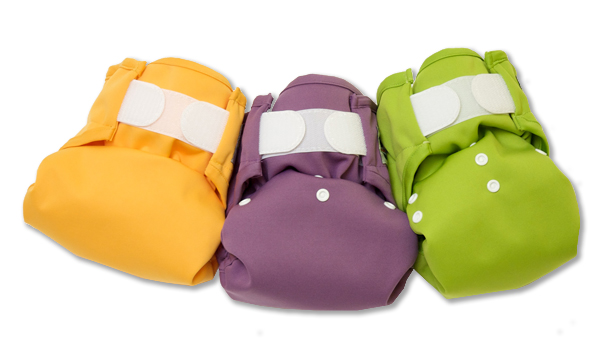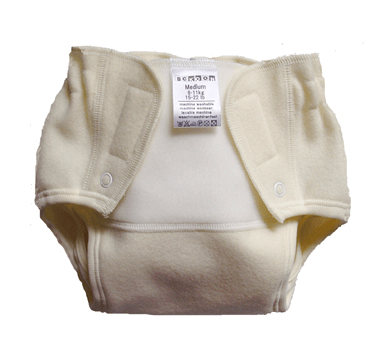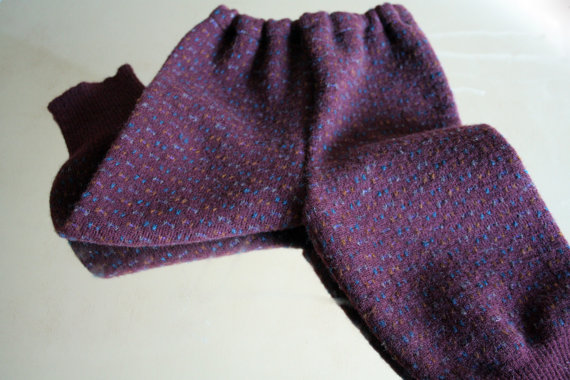Many of my friends have messaged me asking my opinion on cloth diapers, so I thought I’d start a brand-new blog feature here on Oaxacaborn. I’ll do my best to address your cloth diaper questions in a series of posts.

First off, just a little disclaimer: I am not an expert on this in any way. There are countless blogs devoted to nothing but cloth diapering, and many other mamas are much more qualified to talk about cloth diapering than I am. There’s really an entire subculture built around cloth diapers, complete with a myriad of acronyms and vocabulary. (If you want to pick an pro’s brain on the subject, my friend Kristi at Hip Green Baby* is a wealth of knowledge!)
I won’t pretend that I know it all — but, I’ve been exclusively cloth-diapering Aveline since she was six weeks old, and I want you to know that’s easier than it looks, it’s definitely doable, and it saves astronomical amounts of money!
So here’s Part 1, in answer to the commonly asked question —
What brands/kinds of cloth diapers do you use?
Here’s a mini-review of each of the kinds of pocket diapers and diaper covers that I currently use. (I’ll talk about prefolds and other inserts in a later installment.)
GroBaby/GroVia Hybrid Diaper

Formerly GroBaby, GroVia diapers are fantastic. Truly my favorite of all the ones I use. I use the Hybrid diapers, which have a fabric/mesh outer shell with a snap-in thick cotton liner. They have nice, tight elastic on the leg gussets. As with many diapers, you can adjust the rise with the use of snaps, and you can purchase ones with either a velcro or snap closure.
To prepare for wash, you just unsnap the liner to separate it from the cover, and fold the cover velcro onto itself so it doesn’t snag the rest of items in the laundry load.
Pocket Change Diaper
 As far as I can tell, this particular brand isn’t sold anymore — but the concept is alive and well, and is something you can find with any of the other pocket diapers on the market. This type of diaper cover has a pocket into which you slide an insert. You then use the stuffed diaper cover over another liner — either another insert, or cotton prefold diaper which has been folded into thirds. I’ve found that with a slender baby, the thicker the inserts, the better the leg seal.
As far as I can tell, this particular brand isn’t sold anymore — but the concept is alive and well, and is something you can find with any of the other pocket diapers on the market. This type of diaper cover has a pocket into which you slide an insert. You then use the stuffed diaper cover over another liner — either another insert, or cotton prefold diaper which has been folded into thirds. I’ve found that with a slender baby, the thicker the inserts, the better the leg seal.
To prepare for wash, you don’t have to do anything special, since the pocket is open at each end. The agitation of the washer will work the insert out of the pocket.
Huggabuns One-Size Diaper
 This is another pocket-style diaper. It’s probably just Aveline, but I’m not really a fan of the way these snap closed. While the right hand part of the flap closes securely with several rows of snaps, the left-hand flap (the one with the logo on it which wraps over) only has those two snaps. So, to the left of the logo, there’s nothing attaching that flap to the rest of the diaper. After half an hour of wearing a Huggabuns*, my little wiggle-worm always manages to make a disheveled mess of this diaper. Maybe better for a chunky-thighed baby? I do, however, like the inserts and liners which came with this diaper. The hemp/cotton blend is super absorbant.
This is another pocket-style diaper. It’s probably just Aveline, but I’m not really a fan of the way these snap closed. While the right hand part of the flap closes securely with several rows of snaps, the left-hand flap (the one with the logo on it which wraps over) only has those two snaps. So, to the left of the logo, there’s nothing attaching that flap to the rest of the diaper. After half an hour of wearing a Huggabuns*, my little wiggle-worm always manages to make a disheveled mess of this diaper. Maybe better for a chunky-thighed baby? I do, however, like the inserts and liners which came with this diaper. The hemp/cotton blend is super absorbant.
To prepare for wash you’ll have to remove the insert by hand, since (unlike the Pocket Change) the pocket is only open at one end.
Bumwear One Size Diaper

My husband calls this one “the ’80s diaper”. But fear not, Bumwear comes in other patterns/colors as well. This is a pocket diaper, so you’ll need to use an insert and/or a liner. The Bumwear One Size has snap closures, an incredibly soft fleece lining, and a very waterproof outer layer. The leg elastics aren’t the best for my Aveline’s tiny little thighs, but it’ll fit better as she gets bigger. I am sure if you have a chunky-thighed babe you won’t have any trouble with this one. I do like that the elastic is covered by the fleece. It doesn’t leave any red marks on her legs.
You don’t need to do anything extra to prepare this cover for wash.
Thirsties Diaper Covers

This is an entirely different kind of diaper than all the pocket diapers I talked about above. While a pocket or an all-in-one/one-size diaper has to be thrown in the wash after each use, the Thirsties Cover lasts through several diaper changes. It’s a thin, waterproof layer which you use over an absorbant contour or prefold diaper (I’ll talk about these in an upcoming post). These are wonderfully thin, yet leak-proof, and have excellent elastic leg gussets to protect from blowouts. Hands-down favorite cover for sure; I highly recommend these.
To prepare for wash, just fold the velcro over onto itself.
Nature Babies UK Classic Wraps

This is also a very thin, waterproof cover to be used over an absorbant contour or prefold diaper. It’s got great snap closures, tight leg elastic, and an adjustable rise. Plus, it’s available in some very fun patterns! I have no complaints about the Nature Babies Covers; I just love these. In the past, the only thing that would have given the Thirsties a slight edge over the Nature Babies for me, is the Thirsties’ velcro closure. This provides for a more tightly adjustable fit. But, with Aveline so close to being able to un-velcro her own diapers, I’m now leaning toward preferring these snap closures!
You don’t need to do anything extra to prepare this cover for wash.
Dappi Diaper Cover

These are very thin with a mesh and waterproof inner layer and a cotton outer layer. Dappis fasten simply and easily with a wide velcro closure, and like other covers, are meant to last through more than one change. They are by far the cheapest cover I’ve come across – just 2.99 each. But, I have my reservations about these. Despite the incredible ease of use, the velcro isn’t holding up very well. Second, the waterproof layer isn’t really all that waterproof — she’s leaked right through these more than once. (The leaking has occured through the fabric back itself, not through the waist or leg gussets). Still, I keep them in rotation, I just use them during the day when we’re at home and I know I can change her frequently. (And on a frivolous note? The cotton outer layer takes dyes fabulously.)
To prepare for wash, just fold the velcro over onto itself.
Bummis Super Whisper Wrap
 Bummis Super Whisper Wraps are incredibly durable. I’m very happy with how mine have held up. The ones I have were given to me by a friend who had already used them for a full year, and they are still going strong. A waterproof cover with a strong velcro closure, these covers just keep going and going. The elastic leg gussets don’t show any sign of wearing out. A great cover.
Bummis Super Whisper Wraps are incredibly durable. I’m very happy with how mine have held up. The ones I have were given to me by a friend who had already used them for a full year, and they are still going strong. A waterproof cover with a strong velcro closure, these covers just keep going and going. The elastic leg gussets don’t show any sign of wearing out. A great cover.
To prepare for wash, just fold the velcro over onto itself.
Wonder Wraps Diaper Cover
 A thick cover, Wonder Wraps have an adjustable rise and velcro closure, and feel almost as though they are made out of Neoprene. This makes them really bulky, but it also makes them virtually bulletproof and a great choice for overnight diapering. A note about day use — I find that instead of being able to use Wonder Wraps through several diaper changes as they are intended, I can only use them for one use before I put them in the wash (the unique material really retains odor). But, like I said, great for overnight. I’m having trouble locating where these are currently available, however.
A thick cover, Wonder Wraps have an adjustable rise and velcro closure, and feel almost as though they are made out of Neoprene. This makes them really bulky, but it also makes them virtually bulletproof and a great choice for overnight diapering. A note about day use — I find that instead of being able to use Wonder Wraps through several diaper changes as they are intended, I can only use them for one use before I put them in the wash (the unique material really retains odor). But, like I said, great for overnight. I’m having trouble locating where these are currently available, however.
To prepare for wash, just fold the velcro over onto itself.
Sckoon Merino Wool Diaper Cover

If you’ve never used wool diaper covers before, you’re in for a treat. Contrary to what you might think, wool is breathable, water-repellent, naturally anti-bacterial, and no, it’s not itchy at all. This is definitely the best choice for overnight diapering. I definitely recommend you add at least one wool cover to your stash; Aveline has never even come close to leaking while wearing a Sckoon. (Plus, wool is totally dyable — the cover I have has been dyed a pretty pink.)
This brief article about wool wash and lanolin is helpful in learning how to prepare your diapers for wash.
In upcoming installments of Frequently Asked Questions about Cloth Diapers, I’ll talk about
Cloth Diapering on a Budget / Tips on Buying Used Cloth Diapers
Best Practices for Cloth Diaper Laundering and Care
Inserts, Doublers, Contours and Prefolds
Have a question you’d like to see addressed in this series? Leave me a comment!
*Links marked with an asterisk are Hip Green Baby affiliate links. I was not asked to include this link or to mention Hip Green Baby, and I was not compensated or rewarded in any way for doing so. They are not a blog sponsor; but I’ve included them because they’re a really company that I love!
 I quit cloth diapering.
I quit cloth diapering.



 As far as I can tell, this particular brand isn’t sold anymore — but the concept is alive and well, and is something you can find with any of the other pocket diapers on the market. This type of diaper cover has a pocket into which you slide an insert. You then use the stuffed diaper cover over another liner — either another insert, or cotton prefold diaper which has been folded into thirds. I’ve found that with a slender baby, the thicker the inserts, the better the leg seal.
As far as I can tell, this particular brand isn’t sold anymore — but the concept is alive and well, and is something you can find with any of the other pocket diapers on the market. This type of diaper cover has a pocket into which you slide an insert. You then use the stuffed diaper cover over another liner — either another insert, or cotton prefold diaper which has been folded into thirds. I’ve found that with a slender baby, the thicker the inserts, the better the leg seal. This is another pocket-style diaper. It’s probably just Aveline, but I’m not really a fan of the way these snap closed. While the right hand part of the flap closes securely with several rows of snaps, the left-hand flap (the one with the logo on it which wraps over) only has those two snaps. So, to the left of the logo, there’s nothing attaching that flap to the rest of the diaper. After half an hour of wearing a
This is another pocket-style diaper. It’s probably just Aveline, but I’m not really a fan of the way these snap closed. While the right hand part of the flap closes securely with several rows of snaps, the left-hand flap (the one with the logo on it which wraps over) only has those two snaps. So, to the left of the logo, there’s nothing attaching that flap to the rest of the diaper. After half an hour of wearing a 




 A thick cover, Wonder Wraps have an adjustable rise and velcro closure, and feel almost as though they are made out of Neoprene. This makes them really bulky, but it also makes them virtually bulletproof and a great choice for overnight diapering. A note about day use — I find that instead of being able to use Wonder Wraps through several diaper changes as they are intended, I can only use them for one use before I put them in the wash (the unique material really retains odor). But, like I said, great for overnight. I’m having trouble locating where these are currently available, however.
A thick cover, Wonder Wraps have an adjustable rise and velcro closure, and feel almost as though they are made out of Neoprene. This makes them really bulky, but it also makes them virtually bulletproof and a great choice for overnight diapering. A note about day use — I find that instead of being able to use Wonder Wraps through several diaper changes as they are intended, I can only use them for one use before I put them in the wash (the unique material really retains odor). But, like I said, great for overnight. I’m having trouble locating where these are currently available, however.


